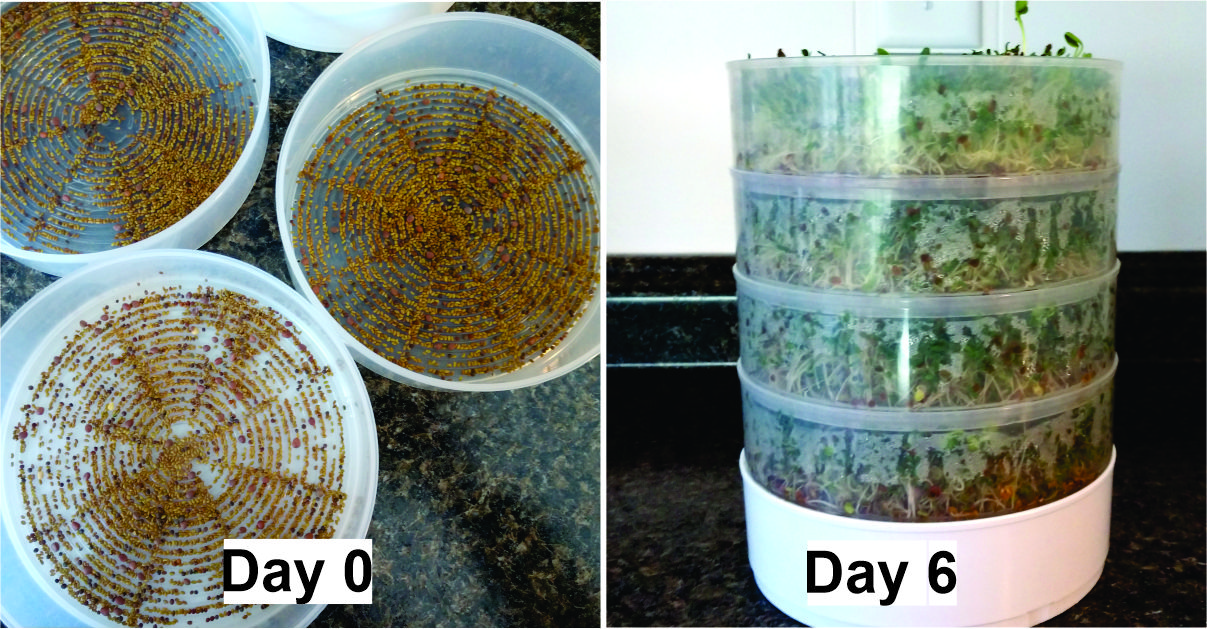How to Grow Sprouts at Home

Sprouts taste amazing in soups, salad, stir-fry, and sandwiches. They have a crunchy texture and are packed with nutrition. They are also the easiest food to grow at home. Even if you are an absolute beginner, even if you do not have a lot of time or space, you can still enjoy some tasty home-grown sprouts. Why is that? Because unlike other types of plants, sprouts do not require soil or light to grow. You only need a container, some seeds, and water.
First of all, choose a container to grow your sprouts. The ideal container should retain moisture while allow airflow. A popular choice is a countertop seed sprouter (affiliate link). Mine has 4 transparent plastic trays that can be stacked vertically, taking a small counter space. These trays have small holes at the bottom, so the water will drip slowly onto the next tray. The bottom tray is made of white plastic and is used for catching water from the sprouting trays. Sprouts do not require light to grow. So you can place the sprouter anywhere you want.
Next, you’ll need some seeds. I recommend using sprouting seeds only to grow sprouts. Sprouting seeds are special seeds that are free of chemicals. If you are sprouting larger seeds as mung beans or peas, pre-soak them in water for 6-8 hours and follow any specific instructions in your seed packet. This will increase your germination rate. I am using a three-part salad mix that contains alfalfa, radish, and broccoli (affiliate link). The seed sizes in this mix are small. I found that for small seeds, pre-soaking is not necessary. I just add a tablespoon of seeds to each train (or until the bottom is covered if using larger seeds).
I water the sprouts three times a day. When watering, I first dump the water in the bottom tray and then add a cup of water to the top tray. I cover the tray loosely with the lid but leave enough gap for airflow. It is important to not seal the lid, or the water won’t drain.
Seeds such as alfalfa, radish, and broccoli usually germinate within 1-3 days. When the sprouts reach the height of the sprouter tray, it’s time to harvest. The whole process only takes a week.
After each harvest, I wash the trays with warm soapy water and clean the seeds out if any got stuck in the drain holes. I dry the trays completely and now they are ready for the next planting. If you want a continuous supply of sprouts, consider starting each tray at a 2-day interval. So you can harvest your sprouts every other day.
What sprouts can you grow and eat?
Many vegetables can also be enjoyed as sprouts, but not all sprouts are edible. My favorite sprouting seeds are salad mix, mung beans, radish, broccoli, and soybeans. Searching for “sprouting seeds” (affiliate link) on Amazon will give you an idea of what seeds are good for sprouts.
Why are mung bean sprouts pink?
Sometimes mung beans can turn pink and have a bitter taste when there is too much light. If that is the case, sprout mung beans in a dark place and harvest the sprouts earlier before they turn pink.
How to keep seeds fresh?
Keep seeds in a tightly sealed bag or container and place them in a cool, dry place. Fortunately, most sprouting seeds come in a self-sealed durable bag. The 3-part salad seeds showed in the above pictures were purchased 3 years ago but the germination rate is still great!
